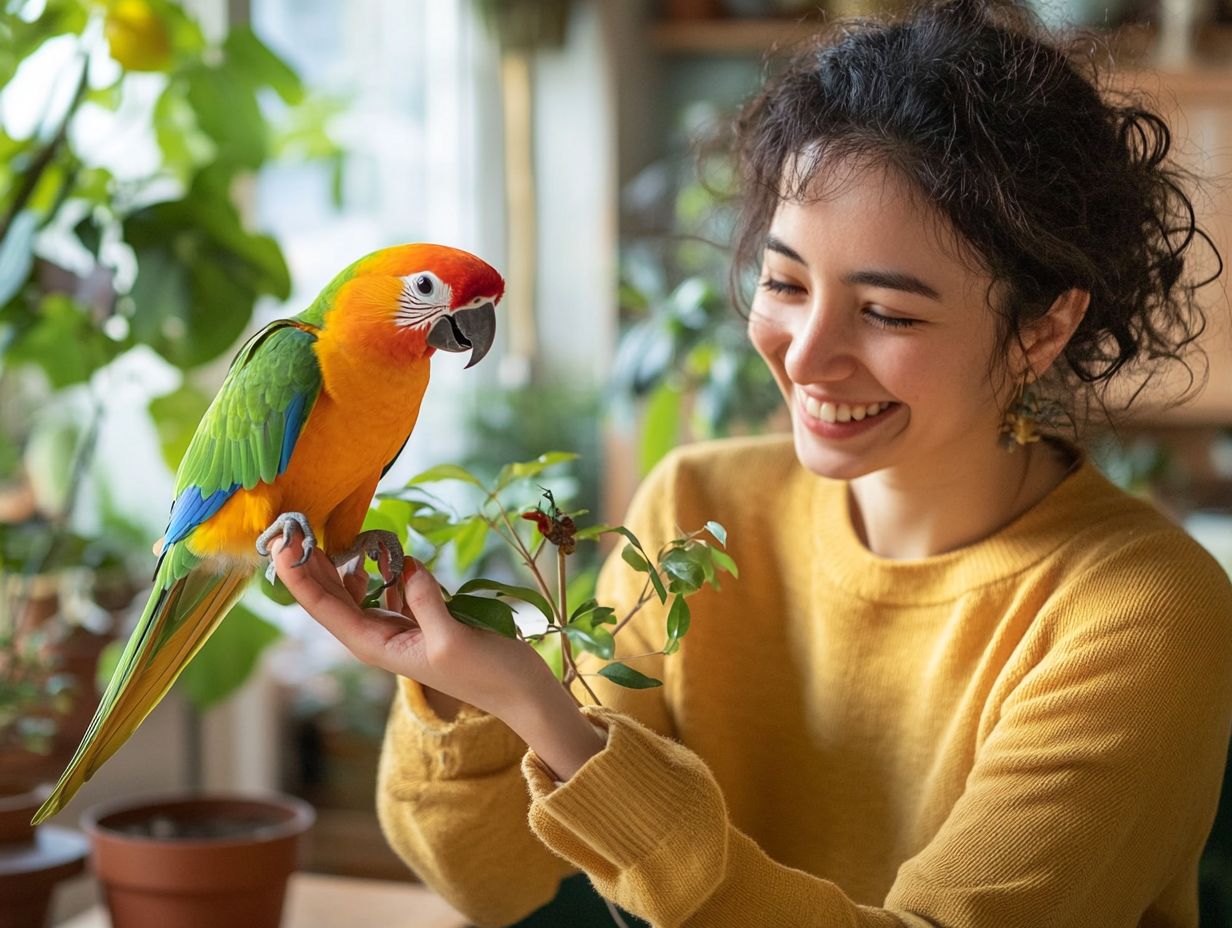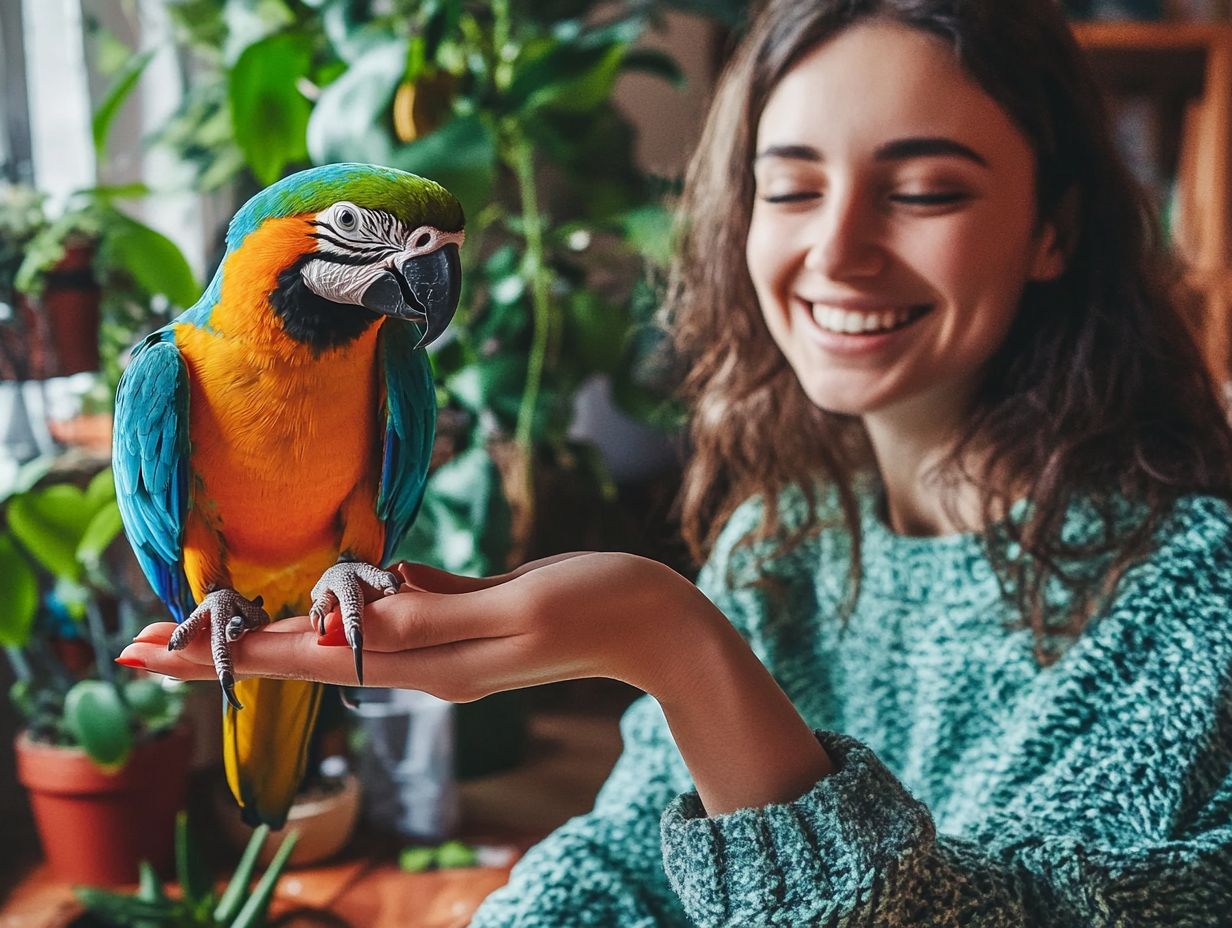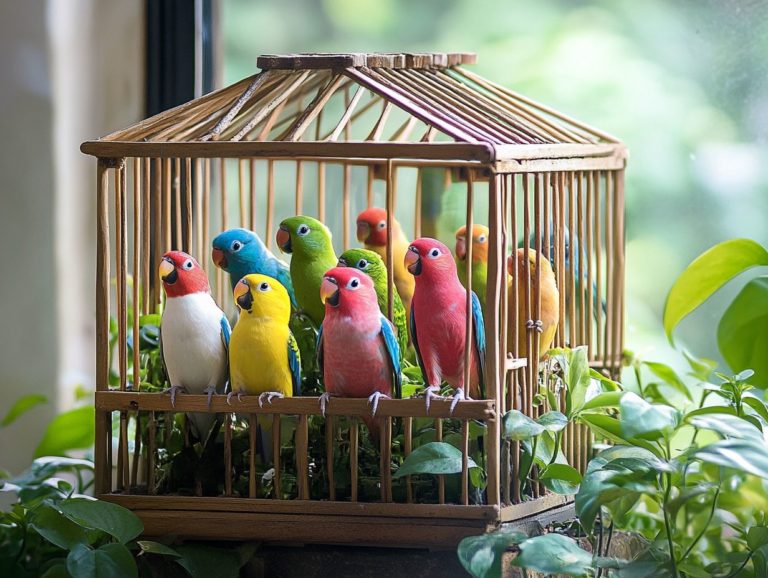How to Foster Interaction with Your Bird
Understanding bird behavior is crucial for you as a bird owner. This knowledge helps you interpret the signals your feathered companion sends your way.
Birds, like parrots and cockatoos, show various behaviors that reflect their emotional states and social needs. By recognizing these behaviors like body language or sounds you can cultivate trust and offer the right attention and socialization your bird needs.
This article delves into communication techniques that will help you build trust and strengthen your bond with your feathered friend. You ll discover engaging activities to encourage play and interaction, as well as effective strategies to manage aggression and fear.
Embrace the journey of fostering a rewarding relationship with your bird!
Contents
- Key Takeaways:
- Understanding Bird Behavior
- Creating a Safe and Comfortable Environment
- Building Trust and Bonding with Your Bird
- Encouraging Interaction and Play
- Dealing with Aggression and Fear
- Frequently Asked Questions
- What are some tips for fostering interaction with my bird?
- How can I build trust and strengthen my relationship with my bird?
- Is it important to socialize my bird with other people and animals?
- What are some signs that my bird is interested in interacting with me?
- How can I prevent my bird from becoming bored or lonely?
- What should I do if my bird seems to be scared or aggressive towards me?
Key Takeaways:

- Understand your bird’s behavior to better communicate and bond with them.
- Create a safe and comfortable environment for your bird to thrive in.
- Use effective communication and training techniques to build trust and encourage interaction.
Understanding Bird Behavior
Common behaviors exhibited by birds can reveal their emotional states and needs. This provides valuable insights into their well-being and happiness while in your care.
For instance, when a bird engages in attention-seeking behaviors like making sounds or moving around, it may be expressing a desire for interaction or stimulation. This signals that it craves companionship or engaging activities.
If you observe your bird enjoying independent playtime, it often indicates comfort and confidence in its surroundings. This suggests it feels secure enough to explore on its own.
Various body language signals such as puffed-up feathers or a tilted head can communicate a spectrum of feelings, from contentment to unease. Recognizing these nuanced communication cues is essential for cultivating a deeper connection between you and your bird, ultimately ensuring a harmonious living environment.
Creating a Safe and Comfortable Environment
A safe and cozy home is a must for your bird s happiness! This profoundly influences their mental stimulation, emotional health, and overall happiness.
A thoughtfully designed cage, filled with appropriate toys and enrichment tools, not only ensures physical comfort but also encourages natural behaviors. This allows your feathered companion to truly thrive.
Regular interaction and a considerate daily routine, complete with quality time outside the cage, can significantly elevate your bird’s quality of life. For more tips, check out this guide on how to keep birds engaged in their cages, nurturing a strong bond between you and your pet.
Essential Elements for a Happy Bird

To ensure your bird thrives and maintains a joyful disposition, it’s essential to incorporate specific elements into its living environment that foster mental stimulation and emotional well-being.
Begin with a thoughtfully arranged cage, brimming with a variety of toys that cater to your bird s natural instincts think foraging, climbing, and chewing. Incorporating swings, ladders, and food puzzles can spark its curiosity and keep it engaged.
Make sure the layout allows ample space for movement and exploration, while also providing safe perches at varying heights for optimal comfort. Environmental factors are crucial as well; ensuring adequate natural light, clean air, and a comfortable temperature will help create a soothing atmosphere that your bird will appreciate.
Don’t overlook the importance of social interaction whether through daily playtime or the companionship of fellow birds this enriches its routine and reinforces a sense of security and contentment.
Building Trust and Bonding with Your Bird
Building trust and bonding with your bird is essential for pet ownership, fostering a positive relationship that enhances your bird’s overall well-being. For tips on maintaining that connection, check out how to keep training fun for your bird.
Using positive reinforcement training methods is key to establishing this connection, giving the power to both you and your bird to engage in meaningful interactions.
By honing in on communication cues and encouraging socialization, you create a safe and nurturing environment for your feathered companion, ensuring they remain engaged and healthy.
This approach builds companionship and trust over time, enriching your shared experience.
Effective Communication and Training Techniques
Effective communication and training techniques are essential for cultivating a strong bond with your bird while boosting its ability to learn new tricks and tasks.
Using positive reinforcement not only encourages desired behaviors but also creates a nurturing environment where your bird feels secure and motivated to participate.
This approach involves rewarding your feathered friend with treats, praise, or playtime whenever it successfully completes a trick, strengthening the connection between you and your pet.
You can teach various basic commands, like step up or wave , to make social interactions smoother and more enjoyable.
As your bird learns these tricks, it becomes more confident and interactive, leading to a more fulfilling experience for both of you.
This enhanced communication ultimately deepens the bond you share.
Encouraging Interaction and Play
Encouraging interaction and play is vital for your bird’s mental and emotional well-being, providing the stimulation and companionship it truly desires. For more tips, check out the best ways to bond with your bird.
Engaging your feathered friend in various activities not only alleviates boredom but also helps you learn how to motivate your bird during training and deepens the bond you share.
Whether through interactive games or toys designed for independent play, ensuring your bird has plenty of entertaining opportunities will lead to a happier, healthier companion in your home.
Fun Activities for You and Your Bird

Incorporating enjoyable activities into your daily routine with your bird stimulates its mind and enhances your interaction, so consider these socialization tips for newly adopted birds to strengthen your bond.
Engaging in interactive games like hide-and-seek or teaching tricks using positive reinforcement can be delightful for both you and your feathered friend. Additionally, learning how to make your bird’s cage more inviting can enhance their playtime experience.
Setting up a mini obstacle course encourages physical activity and provides a chance for your bird to show off its agility.
Training sessions will expand its skill set and create a routine that keeps both of you engaged.
These fun exercises not only keep your bird’s mind sharp; they also foster trust, leading to a happier and more secure avian companion by your side.
Dealing with Aggression and Fear
Navigating aggression and fear in birds can be challenging, but it’s essential for being a responsible pet owner.
By understanding and addressing these behaviors, you can cultivate a more harmonious relationship with your feathered companion.
Strategies for Addressing Problem Behaviors
Implementing effective strategies to address problem behaviors in birds, such as aggression and fear, is crucial for fostering a trusting and safe environment.
Creating a routine that incorporates positive reinforcement techniques encourages desired behaviors while gradually tackling underlying issues.
For example, offering a treat or praise when your bird exhibits calm behavior can significantly reduce instances of aggression.
Gentle handling is equally vital, providing your bird with a comforting sense of security.
Establishing a consistent environment by minimizing sudden changes can help alleviate fear responses.
This nurturing approach modifies behaviors and strengthens the bond between you and your bird, ultimately leading to a more harmonious relationship.
Watch this video for tips on building a trusting relationship with your bird.
Frequently Asked Questions
What are some tips for fostering interaction with my bird?

To foster interaction with your bird, try talking to it in a gentle voice. Additionally, learning how to socialize your new bird by offering treats and playing with toys together can help strengthen your bond.
How can I build trust and strengthen my relationship with my bird?
Spend quality time together to build trust. Activities like grooming, playing, and training are essential.
Yes, socialization helps birds develop proper behaviors and feel comfortable. Introduce your bird to new experiences slowly.
What are some signs that my bird is interested in interacting with me?
If your bird is vocalizing, preening, or moving closer to you, it’s interested in interacting. To enhance this interaction, consider ways to make your bird’s cage more interesting. Pay attention to its body language for mood and preferences.
How can I prevent my bird from becoming bored or lonely?
Make sure your bird has lots of fun activities to keep it happy and engaged! Provide plenty of engaging activities, including toys and foraging, along with regular interaction with you.
What should I do if my bird seems to be scared or aggressive towards me?
If your bird is scared or aggressive, find out why. Identify triggers, consider professional training, or consult a veterinarian to rule out medical issues.
With patience and the right approach, you can help your bird feel safe and loved!






